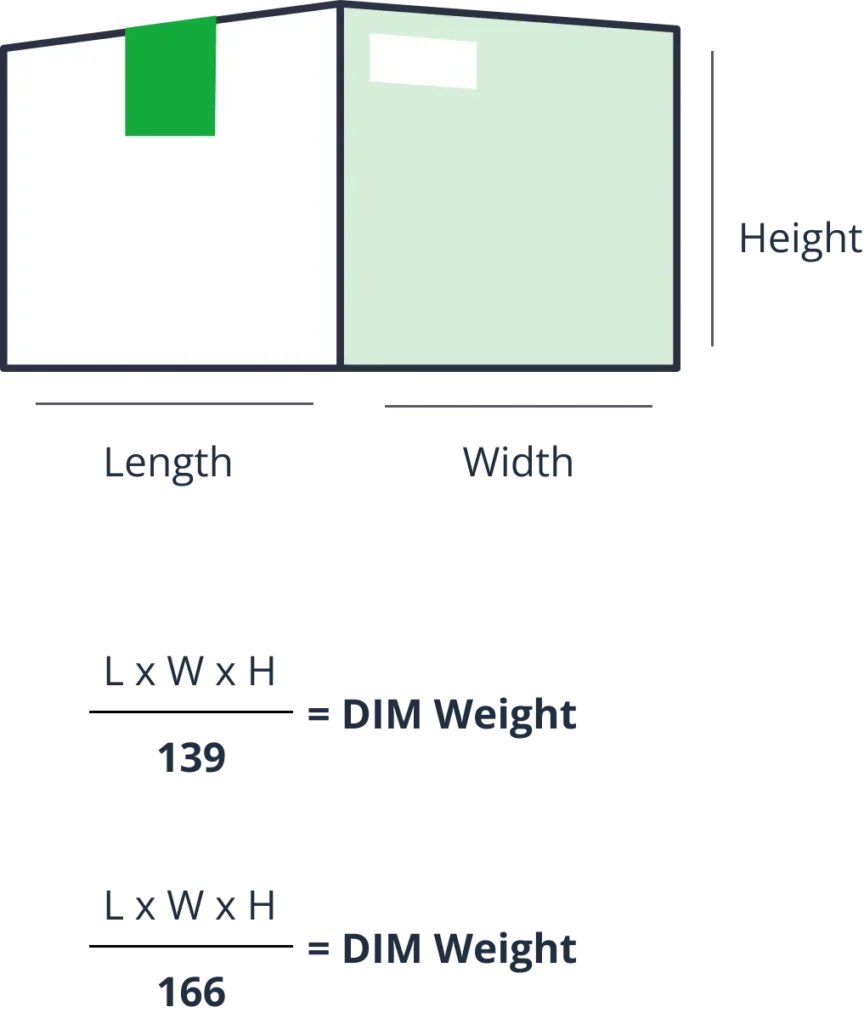Optimize Shipping Costs Efficiently
Dimensional Weight Calculator
Dimensional weight, also known as DIM weight or volumetric weight, is a billing methodology used by shipping carriers to ensure they accurately account for their cost to ship larger packages. Dimensional weight is calculated by a formula that utilizes the shipment’s dimensions and a Dim factor set by the individual shipping carrier.

Calculate your dimensional weight
Get a quote for your product’s likely shipping cost.
Step 1
Use a scale to determine the physical weight of the ready-to-ship package.
Step 2
Measure the length, width, and height of the box. Make sure you always round up the results. For instance, the length of the package is 24.25, round it up to 25.
Step 3
Use the dimensional weight calculator below to determine the base cost to ship the package for each shipping carrier.

Why do shipping carriers utilize dimensional weight?
Shipping carrier business models are centered around loading as many packages into a truck or airplane as they possibly can. As you can imagine, carriers can load many more packages containing smartphones onto a plane than packages containing feather pillows. The carrier’s capacity is significantly constrained by the boxes of pillows, even if both packages are the same physical weight.
Leveraging dimensional weight calculations, carriers can accurately reflect a package’s impact on their network capacities. Ultimately their goal is to maximize their revenue, and charging packages solely on the physical weight does not allow for this, which is why they implemented dimensional weight.

When is dimensional weight applied?
Dimensional weight is applied whenever the physical weight of the package is less than its calculated dimensional weight. If you’re shipping something heavy and compact like a kettlebell, the shipment will typically be billed based on the physical weight of the package. Conversely, when shipping a light and bulky item, like a lightweight bike frame, it is more likely to be billed for dimensional weight.

How is dimensional weight calculated?
Determine the package dimensions, and divide by a DIM Factor:
(Parcel Height x Parcel Width x Parcel Length)/DIM Factor = DIM Weight*
*Rounded up to the nearest whole number
To calculate dimensional weight, measure the length, width, and height of the package. Then multiply the results to obtain the cubic size of your package.
Here’s an example: You have a box measuring 40 in x 16 in x 16 in. Now multiply the three dimensions — 40 times 16 times 16 — which equals 10,240 cubic inches.
Depending on the carrier, you’ll divide the total cubic inches by their unique dimensional weight divisor or “DIM factor”. FedEx and UPS use a DIM factor of 139 DHL and USPS use a DIM factor of 166 (for packages larger than 1,728 cubic inches (or 1 cubic foot). So if you ship that box domestically via UPS, its dimensional weight equals 74 lbs (or 10,240 divided by 139).
Pro Tip:
Make sure you always round up the results. For instance, the length of the package is 24.25, round it up to 25.

How does ShipMonk reduce dimensional weight?
The best way to mitigate dimensional weight is to make each package as small as possible. ShipMonk’s advanced software assigns the smallest possible packaging size to each order. We also train our operations teams to use the most efficient packaging materials to maximize space utilization and reduce shipping costs. We can even remove a product from its original packaging at your request to even further reduce packaging sizes. The savings add up when you partner with ShipMonk!

Need all the details on dimensional weight? We’ve got you.
To learn more about dimensional weight, how it affects ecommerce shipping costs and how to minimize it, read our blog.
